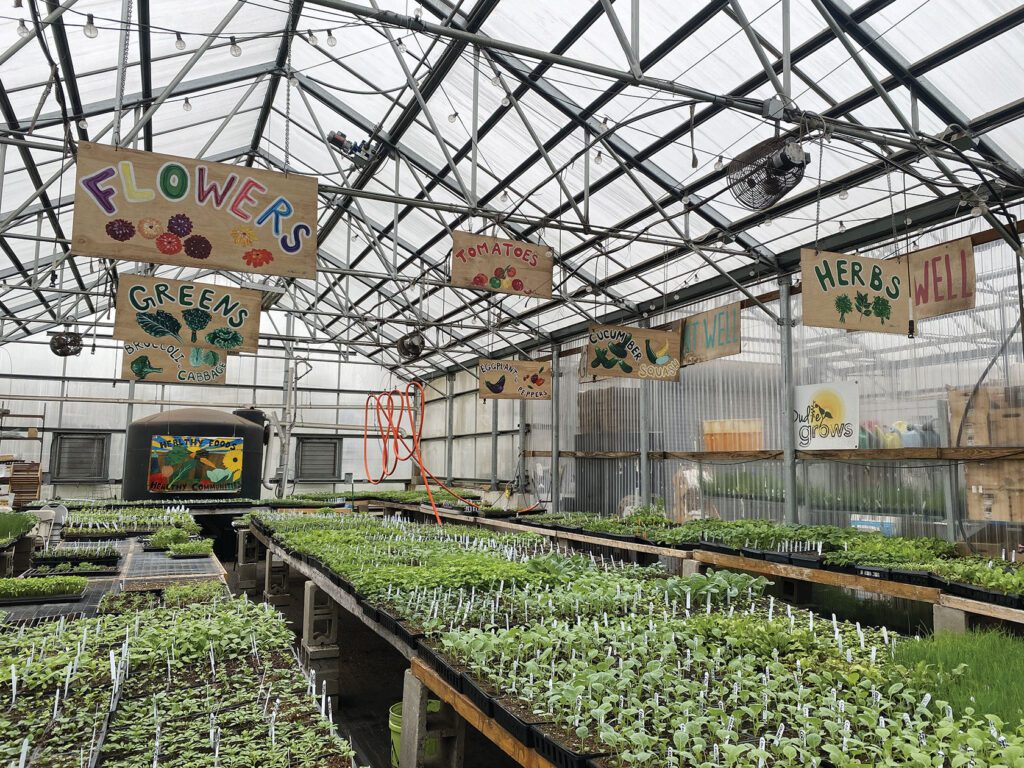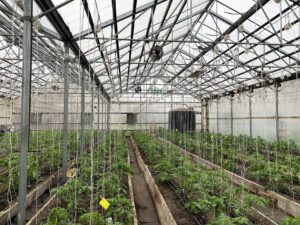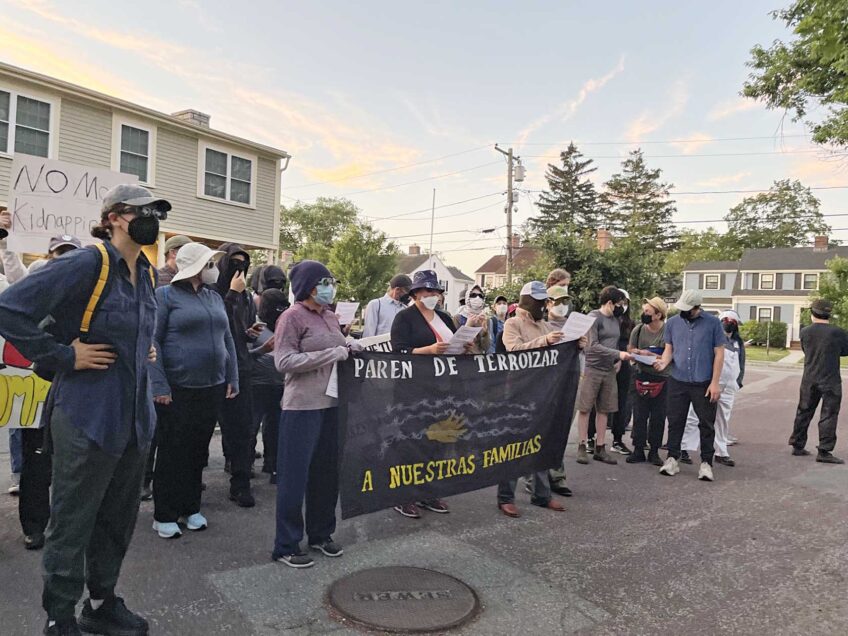
As rain clouds gathered above, Danielle Andrews bent down to reach into the soil in a section of an urban farm in Roxbury. She lodged her hands into the rich dirt and tugged at something underground before pulling out two earth-covered potatoes, one with dozens of tendril-like protrusions sprouting from its skin.
On any day during the harvesting season, what she held in her hands on that April afternoon would be nothing of note. But it was springtime, and the potatoes, which the growers had accidentally left in the ground through the winter, should’ve rotted by then, explained Andrews.
She attributed the anomaly to the once-again mild winter in Massachusetts, which saw an average temperature of 33.6 degrees Fahrenheit between December 2023 and February 2024, according to data from the National Atmospheric and Oceanic Administration.
Walking through the garden, Andrews, Boston farms and greenhouse manager at the Food Project, an urban farm network operating in the city and Lynn, pointed out other unusual growing patterns. She singled out cilantro that had regrown in abnormally plentiful bunches and flushes of chickweed and nettle, weeds that typically begin blooming later in the year.
“When I first started, we generally got a frost in early November. You could pretty much count on a killing frost in early November. And now that can be as late as mid-December, and even then, it’s not necessarily hard,” said Andrews, who joined the Food Project in 2002. Leafy greens such as Swiss chard now survive through winter, and bushels of Winterbor kale that would’ve been decimated by a typical frost stand tall in the garden.
As winter temperatures climb, urban farms and community gardens in Boston’s environmental justice neighborhoods are tasked with adapting to keep food production active, but inconsistent weather patterns make doing so challenging. Some growers serving Boston’s Black and brown populations are concerned that the result could affect community members who rely on urban farms and gardens for fresh produce and gathering spaces.
Recent years are prime examples of erratic climatic conditions. In 2022, the state experienced a drought, “the toughest one that I’ve seen here in Massachusetts since I started farming,” said Andrews. To address the lack of rainfall, she and other urban farmers installed drip tapes — irrigation tools that provide plants with a consistent supply of water.
Last year, however, urban farmers faced a completely different challenge: high rainfall and subsequent regional flooding.
In the past, growers in New England could always “count on a fair amount of rain,” said Andrews. While they used drip tapes, they were never “obsessing over water.” “That definitely changed dramatically, and every season feels very different,” she said, noting that the last two summers flip-flopped between too little rain and too much rain.
“There’s no ambiguity” that New England is warming at a faster pace than the global average, said Yi Ming, professor of climate science and society at Boston College. This has led to an earlier onset of the growing season, which typically runs from about April to October, but has lengthened, according to growers the Banner interviewed. It’s challenging still, Ming said, to establish whether the drought-to-flood pattern of the last two years is merely the result of a long-term hydrological cycle, he said, and how that might affect urban farms and gardens in the future.
“The weather is, in general, a chaotic phenomenon,” he said, adding that it could be decades before scientists arrive at a consensus.
A community service at risk
The positive contributions of urban farms, which the city of Boston legalized in 2013, are well documented, Ming said.
These green spaces lower local temperatures, thanks to the presence of water for evaporation, and are “a good way to alleviate any heat stress,” which is expected to quadruple in Boston in the next 50 years, according to a report by the city. While the scale at which this happens depends on the size of the garden or farm, Ming said “every single bit helps.”
Beyond lowering food transportation costs and trapping carbon emissions, on a community service level, urban farms and gardens increase access to fresh, affordable food in environmental justice communities, which in Massachusetts are low-income neighborhoods inhabited mostly by minorities, according to the state’s website.
The Food Project, for example, grows 25,000 pounds of produce to sell and donate in Dorchester and Roxbury, or to other urban farms, Andrews said.
The Urban Farming Institute, an urban farm and community space in Mattapan, sells fresh fruits, vegetables and herbs at its “Farm Stand Fridays,” beginning in June or July. Like the Food Project, the Urban Farming Institute runs a greenhouse, allowing for the production of a wider variety of plants, particularly those requiring hot and humid conditions, said Amber Dickerson, deputy executive director of the Urban Farming Institute.
In its greenhouse and gardens, the organization prioritizes cultivating produce that its constituents request.
“We just ask our community members: What would you like to see? What is it that we have that you love? And what is it that we don’t have that you’d like to see?” she said. “And a lot of the responses always stem from what they’ve grown up eating…whether that’s growing up in Jamaica, whether that’s growing up in Haiti, whether that’s growing up in Puerto Rico.”
They grow callaloo, the leafy green found in many Caribbean dishes; Trinidadian pimento peppers; and lalo, also called jute leaves, the vegetable used in Haitian cuisine. The urban farm prides itself on meeting the needs of its community, Dickerson said, but in recent years, weather extremes have hindered this service.
During the 2022 drought, temperatures were so high that many of the seedlings planted at the Urban Farming Institute didn’t take, said Pat Spence, president and CEO of the organization. Although tomatoes thrived in the heat, some of the farm’s yields were below average, which meant less to sell at the stand.
Like Andrews and The Food Project, the growers at the Urban Farming Institute implemented drip irrigation to combat the effects of the dry weather. But, when 2023 rolled around, it rained heavily. This time, the tomatoes suffered, producing soggy mildew that attracted pests. The growers even had to chop down their callaloo after it was ravaged by small sap-sucking insects called aphids.
The okra they had planted that summer, which typically grows to be 8 feet tall — “the most beautiful plant,” Spence called it — only reached a height of six feet after an unexpected frost struck in June. Okra had been a hit at “Farm Stand Fridays,” but they had to stop selling it early because it didn’t grow. When community members asked for it, “we just had to say, ‘No more for the season,’” Dickerson said.
While urban farmers and community gardeners attempt to prepare for extreme weather, Spence said doing so has become increasingly challenging. Predicting extreme weather is hard, but even harder is preparing for it.
Growers strategize for the season well in advance, buying seeds at the end of the year and mapping out a week-by-week crop plan. If a heat wave or a cold snap suddenly ensues mid-growing season, they can’t start over, Spence said, which is true for farmers across Massachusetts.
As weather prediction systems by entities such as the National Weather Service improve, said Ming, the Boston College professor, gardeners can begin to rely on them more readily for seasonal outlooks. He added that farms should focus on growing more climate-resilient plants.
An unforeseen weather event can be disruptive, but growers such as those at the Urban Farming Institute see the work they do as serving a broader purpose. “At the end of the day, every time you convert space into growing space, you’re absolutely dealing with the effects of climate change in a positive way, so you want to continue to do that,” said Spence.
The cost of adaptation
In preparation for this year’s growing season, leaders at the Food Project and the Urban Farming Institute said they plan to implement drip irrigation again. The Urban Farming Institute has also been growing plants such as marigolds, basil and dill alongside various crops to repel “bad” insects and attract “good” ones, and covering some of its plants with nets, Spence said.
These adaptation strategies can be pricey.
While Dickerson said she and the Urban Farming Institute’s board members believe the organization is “necessary,” they also have to consider “the real reality of our longevity and of our goals” from monetary and climate change perspectives.
While they hope to be operational for as long as possible, “the question is: Can we and if so, how?” said Dickerson. “With the climate changes and having to adapt to those changes, it is really expensive.”
The community the Urban Farming Institute serves is “not often in a place where they could afford this outside of this space,” Dickerson said of the access to fresh produce the organization provides. The Urban Farming Institute has had to ramp up its fundraising to maintain the affordability of its produce.
As for the Food Project, Andrews said the organization has begun to invest in tarps. They use the large plastic covers to stifle the growth of weeds by hindering germination and to protect plants like tomatoes in the case of frosts. Beyond the initial cost of buying, the tarps need to be replaced every so often as they experience the wear and tear of use, an additional expense.
“I think in some ways, it also feels like it makes everything more expensive,” said Andrews of having to adapt to climatic changes. “Some of the things that we have to do to make sure things are successful [feel] very labor intensive.”
But Andrews, Spence and Dickerson all said they recognize that urban farms provide a vital service. Without the growing spaces, “you’re losing healthy eating without chemicals” and “you’re losing the freshest possible food,” said Spence. She added that places like the Urban Farming Institute are also gathering spaces. “We are so socially isolated right now that it is important that we have a place where community can talk and get together,” she said.
Urban farms aren’t the only growers affected by the changing climate. Boston residents with plots in shared community gardens are faced with similar issues, albeit on a smaller scale.
Many of the plants grown in Eastern Massachusetts tend to be flexible, said Deborah Nam-Krane, a volunteer garden co-coordinator at the Edward L. Cooper Garden and Education Center in Roxbury. But within the last three years, she said, she noticed that the climate has begun to push even against those. Part of her role now is educating community members on how and when to plant to avoid sudden weather changes such as spring frosts.
Most of the people who use the garden, she said, don’t survive solely off what they grow. Instead, Nam-Krane explained, what most people go to the garden for, beyond the magic of witnessing something bourgeon from the ground, “is a place that they can feel a bit of a respite,” a place where they can gather.
“If we start to see the community gardens disappearing because it’s just not viable to grow…what the gardeners lose is a place where they can unwind, unload, build community relations.”







